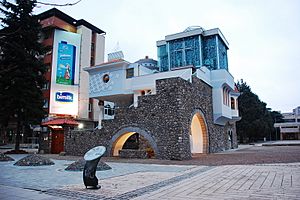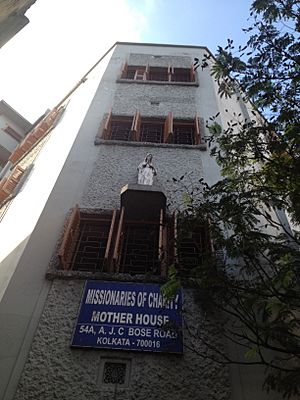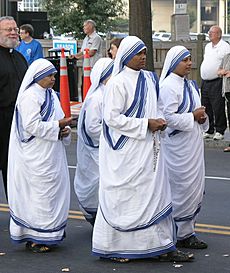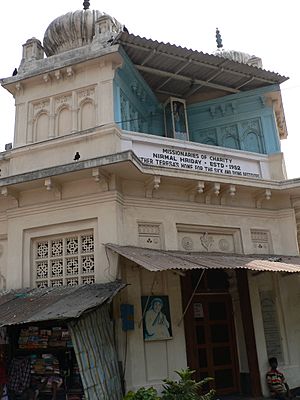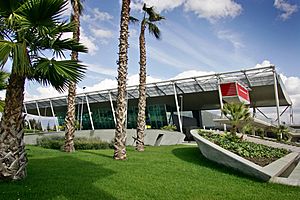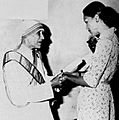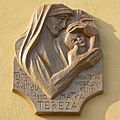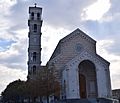Mother Teresa facts for kids
Quick facts for kids SaintTeresa of Calcutta MC |
|
|---|---|
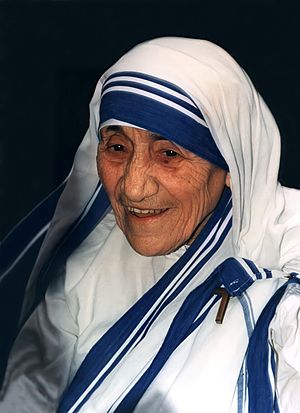
Mother Teresa in 1995
|
|
| Virgin | |
| Born | Anjezë Gonxhe Bojaxhiu 26 August 1910 Üsküp, Kosovo Vilayet, Ottoman Empire (present-day Skopje, North Macedonia) |
| Died | 5 September 1997 (aged 87) Calcutta, West Bengal, India |
| Venerated in | Catholic Church |
| Beatified | 19 October 2003, Saint Peter's Square, Vatican City by Pope John Paul II |
| Canonized | 4 September 2016, Saint Peter's Square, Vatican City by Pope Francis |
| Major shrine | Mother House of the Missionaries of Charity, Calcutta, West Bengal, India |
| Feast | 5 September |
| Patronage |
|
Mary Teresa Bojaxhiu MC (born Anjezë Gonxhe Bojaxhiu 26 August 1910 – 5 September 1997), better known as Mother Teresa, was an Albanian Catholic nun and the founder of the Missionaries of Charity. Born in Skopje, then part of the Ottoman Empire, at the age of 18 she moved to Ireland and later to India, where she lived most of her life. On 4 September 2016, she was canonised by the Catholic Church as Saint Teresa of Calcutta. The anniversary of her death, 5 September, is her feast day.
Mother Teresa founded Missionaries of Charity, a religious congregation, which grew to have over 4,500 nuns across 133 countries as of 2012[update]. The congregation manages homes for people who are dying of HIV/AIDS, leprosy, and tuberculosis. The congregation also runs soup kitchens, dispensaries, mobile clinics, children's and family counselling programmes, as well as orphanages and schools. Members take vows of chastity, poverty, and obedience and also profess a fourth vow: to give "wholehearted free service to the poorest of the poor."
Mother Teresa received several honours, including the 1962 Ramon Magsaysay Peace Prize and the 1979 Nobel Peace Prize.
Contents
Childhood
Mother Teresa's given name was Anjezë Gonxhe (or Gonxha) Bojaxhiu. Gonxhe means "rosebud" or "little flower" in Albanian). She was born on 26 August 1910 into a Kosovar Albanian family in Skopje, Ottoman Empire (now the capital of North Macedonia). She was baptised in Skopje the day after her birth.
She was the youngest child of Nikollë and Dranafile Bojaxhiu (Bernai). Her father, who was involved in Albanian-community politics in Ottoman North Macedonia, died in 1919 when she was eight years old.
Anjezë was in her early years when she became fascinated by stories of the lives of missionaries and their service in Bengal; by age 12, she was convinced that she should commit herself to religious life.
Life in India
Anjezë left home in 1928 at age 18 to join the Sisters of Loreto at Loreto Abbey in Rathfarnham, Ireland, to learn English with the intent of becoming a missionary; English was the language of instruction of the Sisters of Loreto in India. She saw neither her mother nor her sister again. Her family lived in Skopje until 1934, when they moved to Tirana.
She arrived in India in 1929 and began her novitiate in Darjeeling, in the lower Himalayas, where she learned Bengali and taught at St. Teresa's School near her convent. She took her first religious vows on 24 May 1931. She chose to be named after Thérèse de Lisieux, the patron saint of missionaries; because a nun in the convent had already chosen that name, she opted for its Spanish spelling of Teresa.
Teresa took her solemn vows on 14 May 1937 while she was a teacher at the Loreto convent school in Entally, eastern Calcutta. She served there for nearly twenty years and was appointed its headmistress in 1944. Although Mother Teresa enjoyed teaching at the school, she was increasingly disturbed by the poverty surrounding her in Calcutta. The Bengal famine of 1943 brought misery and death to the city.
In 1946, during a visit to Darjeeling by train, Mother Teresa felt that she heard the call of her inner conscience to serve the poor of India for Jesus. She asked for and received permission to leave the school. In 1950, she founded the Missionaries of Charity, choosing a white sari with two blue borders as the order's habit.
Missionaries of Charity
On 10 September 1946, Teresa experienced what she later described as "the call within the call" when she travelled by train to the Loreto convent in Darjeeling from Calcutta for her annual retreat.
She began missionary work with the poor in 1948, replacing her traditional Loreto habit with a simple, white cotton sari with a blue border. Mother Teresa adopted Indian citizenship, spent several months in Patna to receive basic medical training at Holy Family Hospital and ventured into the slums. She founded a school in Motijhil, Calcutta, before she began tending to the poor and hungry. At the beginning of 1949, Mother Teresa was joined in her effort by a group of young women, and she laid the foundation for a new religious community helping the "poorest among the poor".
Her efforts quickly caught the attention of Indian officials, including the prime minister. Mother Teresa wrote in her diary that her first year was fraught with difficulty. With no income, she begged for food and supplies and experienced doubt, loneliness and the temptation to return to the comfort of convent life during these early months.
On 7 October 1950, Mother Teresa received Vatican permission for the diocesan congregation, which would become the Missionaries of Charity. In her words, it would care for "the hungry, the naked, the homeless, the crippled, the blind, the lepers, all those people who feel unwanted, unloved, uncared for throughout society, people that have become a burden to the society and are shunned by everyone".
In 1952, Mother Teresa opened her first hospice with help from Calcutta officials. She converted an abandoned Hindu temple into the Kalighat Home for the Dying, free for the poor, and renamed it Kalighat, the Home of the Pure Heart (Nirmal Hriday). Those brought to the home received medical attention and the opportunity to die with dignity in accordance with their faith: Muslims were read the Quran, Hindus received water from the Ganges, and Catholics received extreme unction.
She opened a hospice for those with leprosy, calling it Shanti Nagar (City of Peace). The Missionaries of Charity established leprosy-outreach clinics throughout Calcutta, providing medication, dressings and food. The Missionaries of Charity took in an increasing number of homeless children; in 1955, Mother Teresa opened Nirmala Shishu Bhavan, the Children's Home of the Immaculate Heart, as a haven for orphans and homeless youth.
The congregation began to attract recruits and donations, and by the 1960s it had opened hospices, orphanages and leper houses throughout India. Mother Teresa then expanded the congregation abroad, opening a house in Venezuela in 1965 with five sisters. Houses followed in Italy (Rome), Tanzania and Austria in 1968, and, during the 1970s, the congregation opened houses and foundations in the United States and dozens of countries in Asia, Africa and Europe.
The Missionaries of Charity Brothers was founded in 1963, and a contemplative branch of the Sisters followed in 1976. Lay Catholics and non-Catholics were enrolled in the Co-Workers of Mother Teresa, the Sick and Suffering Co-Workers, and the Lay Missionaries of Charity. Responding to requests by many priests, in 1981, Mother Teresa founded the Corpus Christi Movement for Priests and with Joseph Langford founded the Missionaries of Charity Fathers in 1984 to combine the vocational aims of the Missionaries of Charity with the resources of the priesthood.
By 1997, the 13-member Calcutta congregation had grown to more than 4,000 sisters who managed orphanages, AIDS hospices and charity centers worldwide, caring for refugees, the blind, disabled, aged, alcoholics, the poor and homeless and victims of floods, epidemics and famine. By 2007, the Missionaries of Charity numbered about 450 brothers and 5,000 sisters worldwide, operating 600 missions, schools and shelters in 120 countries.
International charity
Mother Teresa made occasional trips outside India for humanitarian reasons. These included, in 1971, a visit with four of her sisters, to Troubles-era Belfast.
At the height of the Siege of Beirut in 1982, Mother Teresa rescued 37 children trapped in a front-line hospital by brokering a temporary cease-fire between the Israeli army and Palestinian guerrillas. Accompanied by Red Cross workers, she travelled through the war zone to the hospital to evacuate the young patients.
Mother Teresa travelled to assist the hungry in Ethiopia, radiation victims at Chernobyl and earthquake victims in Armenia. In 1991 she returned to Albania for the first time, opening a Missionaries of Charity Brothers home in Tirana.
By 1996, the Missionaries of Charity operated 517 missions in over 100 countries. The number of sisters in the Missionaries of Charity grew from twelve to thousands, serving the "poorest of the poor" in 450 centres worldwide. The first Missionaries of Charity home in the United States was established in the South Bronx area of New York City, and by 1984 the congregation operated 19 establishments throughout the country.
Declining health and death
Mother Teresa had a heart attack in Rome in 1983 while she was visiting Pope John Paul II. Following a second attack in 1989, she received a pacemaker. In 1991, after a bout of pneumonia in Mexico, she had additional heart problems. Although Mother Teresa offered to resign as head of the Missionaries of Charity, in a secret ballot the sisters of the congregation voted for her to stay, and she agreed to continue.
In April 1996, Mother Teresa fell, breaking her collarbone, and four months later she had malaria and heart failure. Although she underwent heart surgery, her health was clearly declining. According to Archbishop of Calcutta Henry Sebastian D'Souza, he ordered a priest to perform an exorcism (with her permission) when she was first hospitalised with cardiac problems because he thought she might be under attack by the devil.
On 13 March 1997, Mother Teresa resigned as head of the Missionaries of Charity. She died on 5 September.
Mother Teresa lay in repose in an open casket in St Thomas, Calcutta, for a week before her funeral. She received a state funeral from the Indian government in gratitude for her service to the poor of all religions in the country.
Interesting facts about Mother Teresa
- Mother Teresa considered 27 August, the day she was baptised, her "true birthday".
- She was fluent in five languages – Bengali, Albanian, Serbian, English and Hindi.
- During her life and after her death, Mother Teresa was admired by many for her charitable work, but was criticised for some of her views, as well as the poor conditions in her houses for the dying.
- Her authorised biography, written by Navin Chawla, was published in 1992, and she has been the subject of many other works.
- On 6 September 2017, Mother Teresa and Saint Francis Xavier were named co-patrons of the Roman Catholic Archdiocese of Calcutta.
- Mother Teresa has been commemorated by museums and named the patroness of a number of churches.
- She has had buildings, roads and complexes named after her, including Albania's international airport.
- Mother Teresa Day (Dita e Nënë Terezës), 19 October, is a public holiday in Albania.
- In 2012, Mother Teresa was ranked number 5 in Outlook India's poll of the Greatest Indian.
- Indian Railways introduced the "Mother Express", a new train named after Mother Teresa, on 26 August 2010 to commemorate the centenary of her birth.
- Sacred Heart University in Fairfield, Connecticut, has a residence hall named after her, called Teresa of Calcutta Hall.
- Beginning on 5 September 2013, the anniversary of her death has been designated the International Day of Charity by the United Nations General Assembly.
Mother Teresa quotes
- “If you judge people, you have no time to love them.”
- “Not all of us can do great things. But we can do small things with great love.”
- “Peace begins with a smile.”
- “The most terrible poverty is loneliness, and the feeling of being unloved.”
- “Kind words can be short and easy to speak, but their echoes are truly endless.”
- “It's not how much we give but how much love we put into giving.”
- “God doesn't require us to succeed, he only requires that you try.”
Miracle and beatification
After Mother Teresa's death in 1997, the Holy See began the process of beatification.
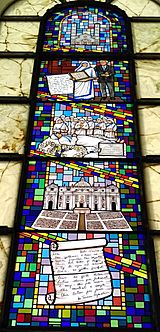
The process of canonisation requires the documentation of a miracle resulting from the intercession of the prospective saint. In 2002 the Vatican recognised as a miracle the healing of a tumour in the abdomen of Monica Besra, an Indian woman, after the application of a locket containing Teresa's picture. According to Besra, a beam of light emanated from the picture and her cancerous tumour was cured; however, her husband and some of her medical staff said that conventional medical treatment eradicated the tumour.
During Mother Teresa's beatification and canonisation, the Vatican studied published and unpublished criticism of her life and work. No obstacle to Mother Teresa's canonisation was found. Mother Teresa was beatified on 19 October 2003, and was known by Catholics as "Blessed".
Canonization
On 17 December 2015, the Vatican Press Office confirmed that Pope Francis recognised a second miracle attributed to Mother Teresa: the healing of a Brazilian man with multiple brain tumours back in 2008. The miracle first came to the attention of the postulation (officials managing the cause) during the events of World Youth Day 2013 when the pope was in Brazil that July. A subsequent investigation took place in Brazil from 19–26 June 2015 which was later transferred to the Congregation for the Causes of Saints who issued a decree recognizing the investigation to be completed.
Pope Francis canonised her at a ceremony on 4 September 2016 in St. Peter's Square in Vatican City. Tens of thousands of people witnessed the ceremony, including 15 government delegations and 1,500 homeless people from across Italy. It was televised live on the Vatican channel and streamed online; Skopje, Mother Teresa's hometown, announced a week-long celebration of her canonisation. In India, a special Mass was celebrated by the Missionaries of Charity in Calcutta.
Images for kids
-
President Ronald Reagan presents Mother Teresa with the Presidential Medal of Freedom at a White House ceremony as First Lady Nancy Reagan looks on, 20 June 1985.
-
Plaque dedicated to Mother Teresa in Wenceslas Square, Olomouc, Czech Republic
-
Cathedral of Saint Mother Teresa, Prishtinë
See also
 In Spanish: Teresa de Calcuta para niños
In Spanish: Teresa de Calcuta para niños
- Abdul Sattar Edhi
- Albanians
- List of Albanians
- List of female Nobel laureates
- The Greatest Indian
- Roman Catholicism in Albania
- Roman Catholicism in Kosovo
- Roman Catholicism in North Macedonia


